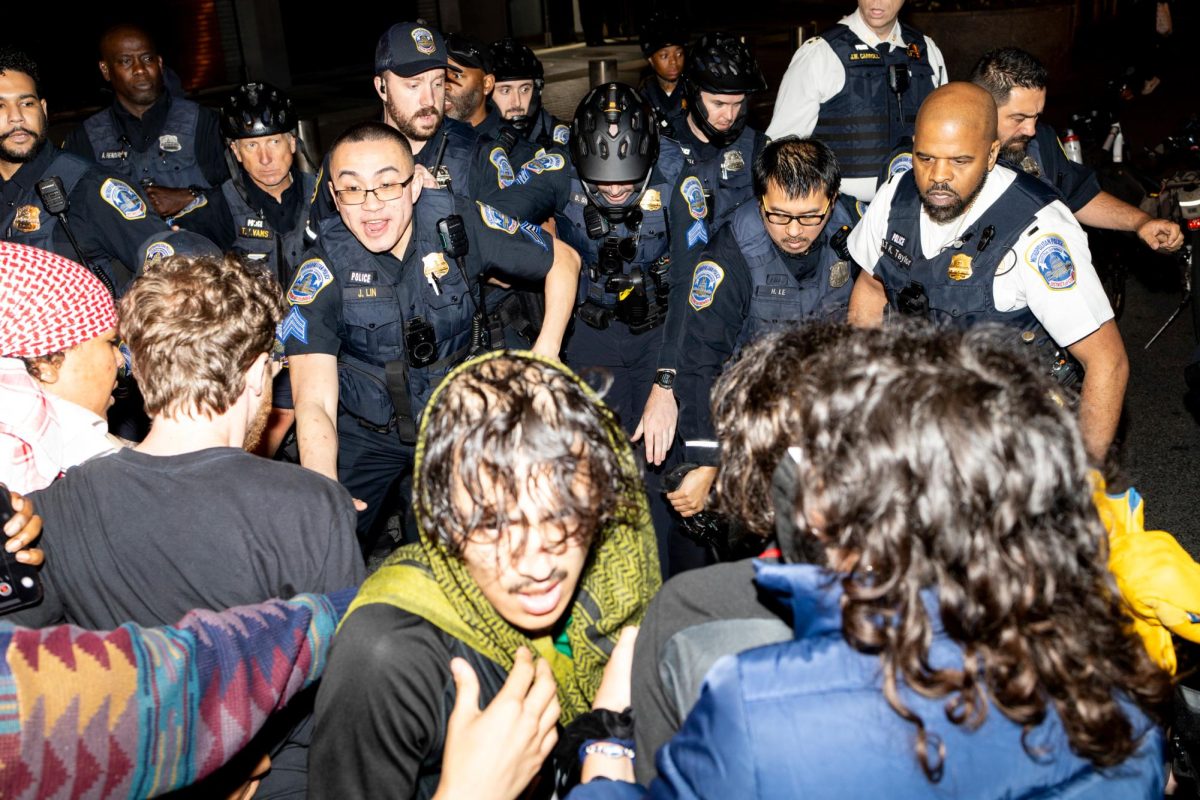The Elliott School of International Affairs will eliminate a pair of stand-alone master’s degree programs.
Officials will phase out the European and Eurasian Studies and Latin American and Hemispheric Studies programs over the next two academic years and will stop accepting new applicants this fall, according to emails from Elliott School Dean Alyssa Ayres that were obtained by The Hatchet. An email states that officials are discontinuing the programs due to low enrollment, narrow financial viability and difficulty retaining full-time faculty.
“The direct and indirect costs of such expansive service obligations, as well as the fact it disproportionately falls upon our contract faculty colleagues raising issues of equity and fairness, has to be weighed against the large number of programs we administer,” Ayres said in an Aug. 18 email to faculty that was obtained by The Hatchet.
Students currently enrolled in the programs may complete the remainder of their degrees or transfer into a master of arts in international affairs, or MAIA, where they can concentrate on specific regions, including Latin America or Europe, Eurasia and Russia, according to the email. After the programs phase out, new students will no longer be able to earn region-specific degrees. Instead, they will have to earn the umbrella MAIA degree with concentrations in their preferred region.
Students pursuing the MAIA degree must complete a 12 credit concentration with either a thematic specialization — like democratic studies and global health — or a region-specific focus, including Latin America; Europe, Eurasia and Russia; the Middle East; Africa; and Asia. The former stand-alone programs required 40 credits that largely had a region-specific focus.
“This shift in our administration of these specializations will not lead to personnel changes nor will it degrade our teaching in these areas,” Ayres said in the email. “We will continue to offer our students the opportunity to study these regions in depth through our MAIA program, led by our world-class faculty.”
Despite officials announcing the end of the programs in an email to faculty Aug. 18 and students Sept. 6, the program’s website continued to advertise the two programs until Sept. 21, when officials updated the listing to indicate they will no longer accept new students.
A student in the Latin American and Hemispheric Studies program who spoke under the condition of anonymity for fear of retribution from the University, said they feel the program’s termination “devalues” their degree. The student said the concentration option for MAIA only allows students to take a couple of classes about the region, which limits the more specialized education students could be seeking.
“You’re never going to receive the well rounded and very comprehensive understanding of the trials and tribulations of the region without this masters,” they said.
In the dueling emails, Ayres told professors that students in the program could transfer into the MAIA but did not specify in her email to students that transferring was an option, leaving some enrolled students unsure about their academic futures in the program, or outside of it.
“I think that that lack of information, that lack of transparency is very unfair,” the student said.
University spokesperson Julia Metjian said the stand-alone master’s programs “consistently experienced” low enrollment, with seven students enrolling in each program this year. She said placing the studies “under the umbrella” of the MAIA degree will allow students to continue studying the regions through concentrations but did not specify what classes within the programs will still be available for students to take through the concentrations.
Last academic year, 23 students enrolled in the European and Eurasian Studies program — a drop from the 30 enrolled a decade prior in 2012, according to the University’s enrollment dashboard. The Latin American and Hemispheric Studies program enrolled 19 students in 2022, compared to 22 in 2012. A total of 745 students enrolled in all Elliott graduate programs in 2022, the lowest number since at least 2012.
Diego Abente Brun, the director of the Latin American and Hemispheric Studies program and a professor of practice of international affairs, said officials are “redesigning” how students focus on the region by directing the same “quality” offerings provided in the program to the concentration.
“We are confident that we’re going to be offering our students in the future an opportunity to have a very strong Latin American concentration within MAIA and the students that are here in the program right now will continue to have the courses and the quality of learning that they deserve,” Brun said.
Hope M. Harrison, the former director of the European and Eurasian Studies program and a professor of history and international affairs, said while the elimination of the stand-alone program is a loss, the remaining regional concentration will allow students to express their interest in the areas of study on their transcripts.
“I do think it’s unfortunate that it won’t be as it has been with its own program,” said Harrison, who directed the program between 2008 and 2009. “We’ve long had a concentration that is also an option, doing the broader master’s of international affairs but having a concentration in it means less courses than when it’s a stand-alone master’s program.”
Harrison said the announcement came as a “surprise” because she was unaware that termination of the program was a possibility.
“While the format is changing, I personally, and all of us, are still just as committed as we always have been to teaching about these parts of the world because that’s what our expertise is in,” Harrison said.
Gema Kloppe-Santamaría, an assistant professor of history and international affairs, said the lack of an “institutional umbrella” for Latin American and Hemispheric Studies will make it more difficult for students to find faculty and classes focused on this area of study at GW.
“For me, the greater loss is sort of losing the umbrella that gives cohesiveness to everybody that is engaged in Latin America,” Kloppe-Santamaría said.
Kloppe-Santamaría said she recently agreed to be the faculty sponsor for LATAM@GW, an organization that unites students interested in Latin America and the Caribbean. She said in this role, she hopes she can contribute to establishing a community for people interested in Latin American studies and feels “more compelled” to make its presence clear after officials discontinued the program.
“I was saddened by the news,” Kloppe-Santamaría said. “At the same time, I take this as an opportunity to work with faculty and students that I know want Latin American history to remain a central part, or a core part, of GW.”





